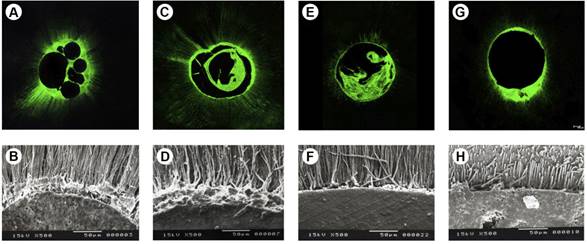Abstract
The influence of root canal filling techniques on the penetration of AH Plus into dentinal tubules was evaluated using confocal laser scanning microscopy (CLSM) and the impact on the bond strength of the filling material on the root dentin was evaluated using the push-out test. Roots of the maxillary central incisors (n=40) were prepared with ProTaper Universal and assigned to four groups: lateral condensation, vertical compaction, modified Tagger hybrid and single cone. After root canal filling with gutta-percha and AH Plus, along with the addition of 0.01% fluorescein, the roots were cut into 2-mm slices. CLSM was performed on the first slice of each root third, followed by the push-out test. The second slice was analyzed under SEM. ANOVA demonstrated a statistically significant difference between the root canal filling techniques and the root thirds (p<0.05). For percent penetration, Tukey’s test showed that the vertical compaction (91.77±13.51), lateral condensation (89.18±10.91) and modified Tagger hybrid (87.53±15.42) presented the highest values, which significantly differed (p<0.05) from those of the single cone (78.19±22.46). For bond strength (MPa), lateral condensation (3.42±0.54) and vertical compaction (3.47±0.53) had the highest values (p<0.05), while the modified Tagger hybrid (2.19±0.41) and single cone (0.54±0.21) had the lowest. In conclusion, the lateral condensation, vertical compaction and Modified Tagger’s hybrid techniques resulted in greater penetration and bond strength to the intra-radicular dentin.
Key Words:
endodontics; confocal laser scanning microscopy; bond strength

 Thumbnail
Thumbnail
